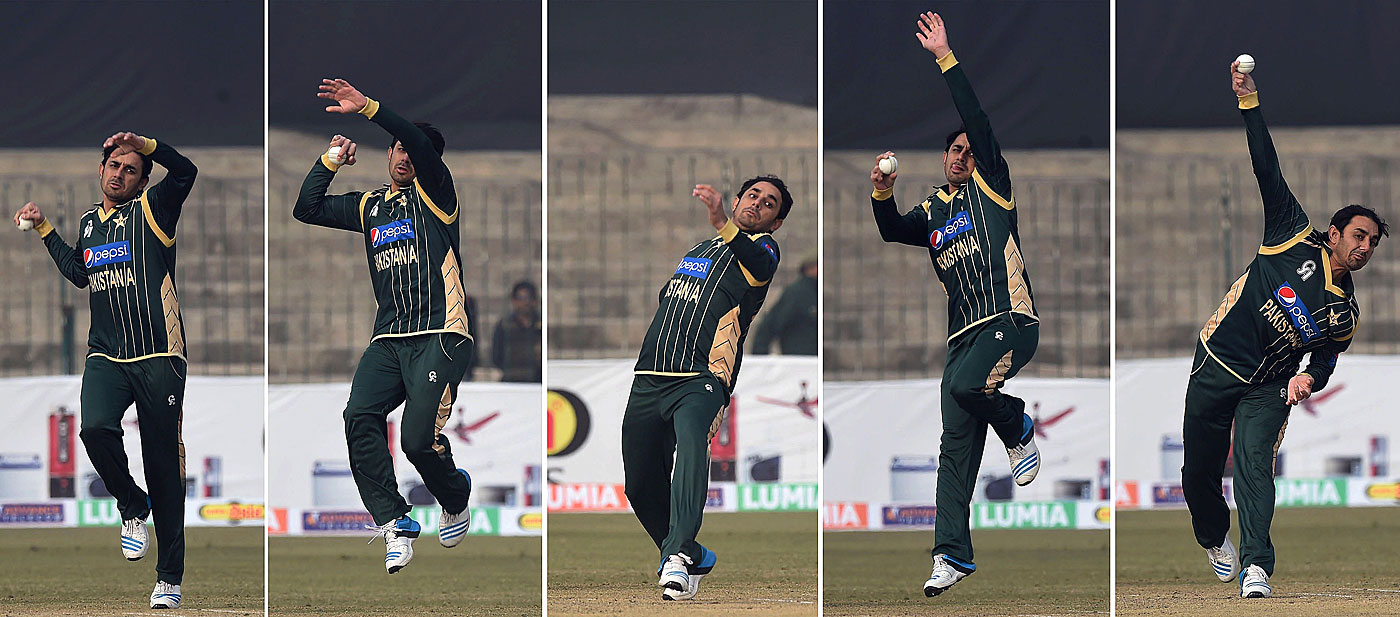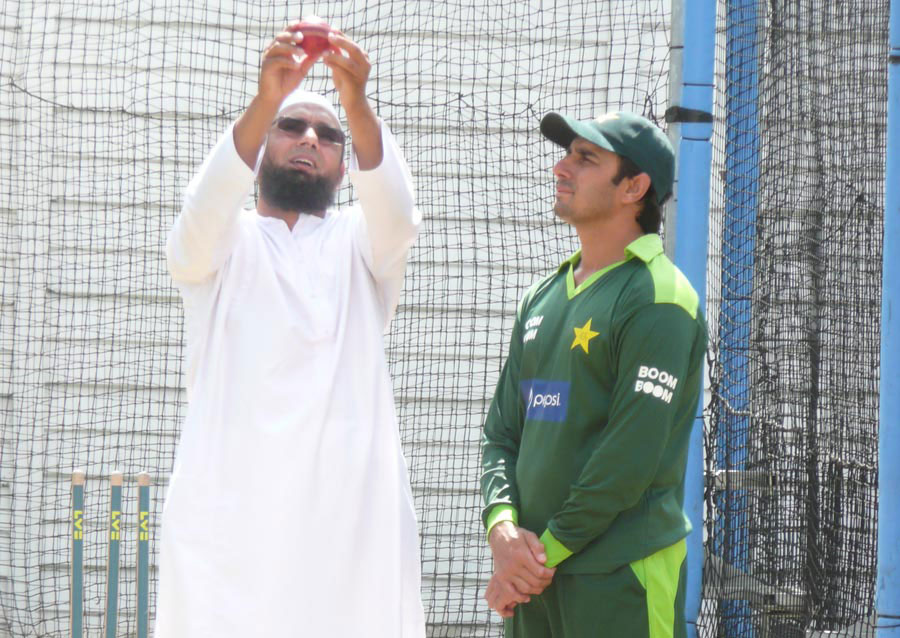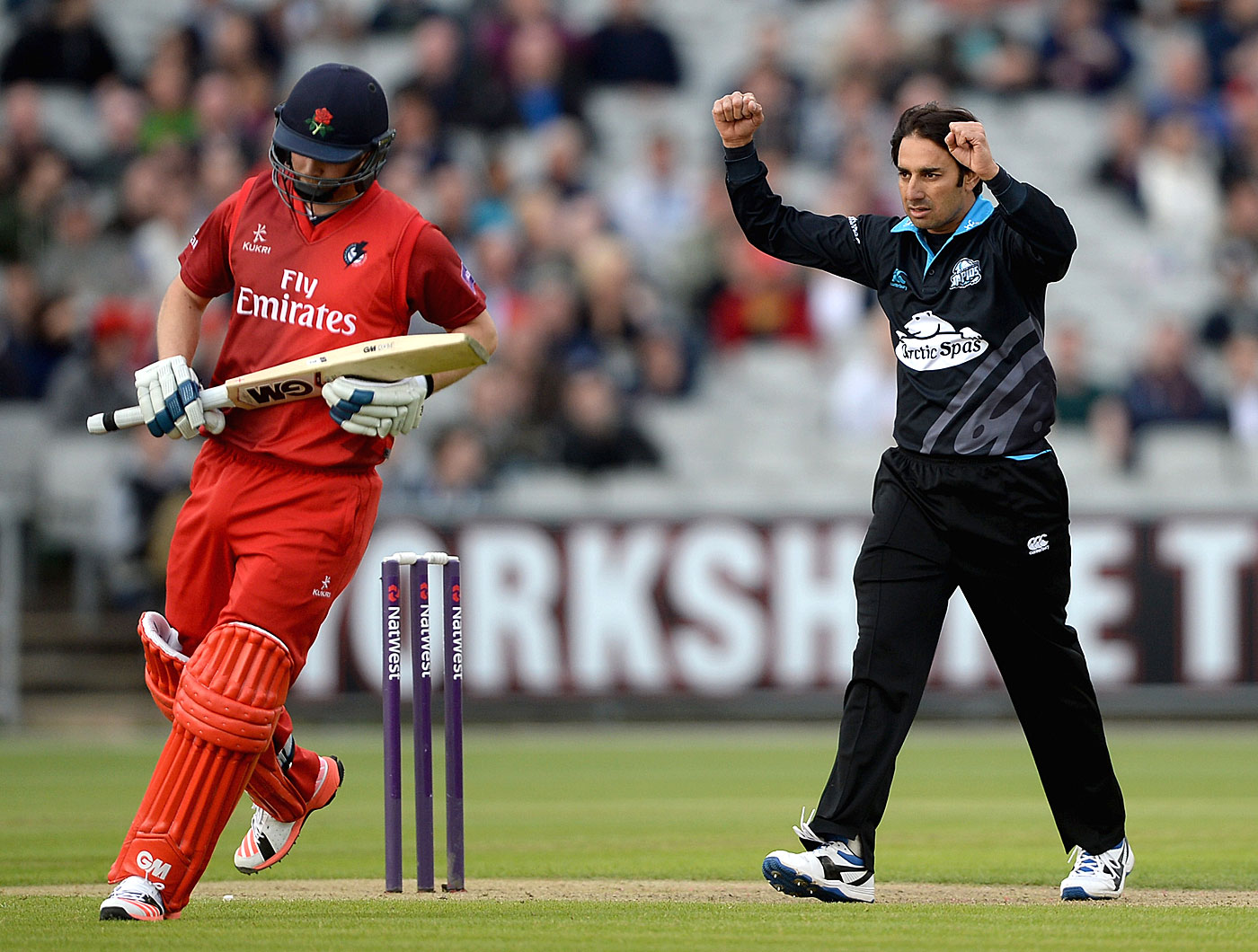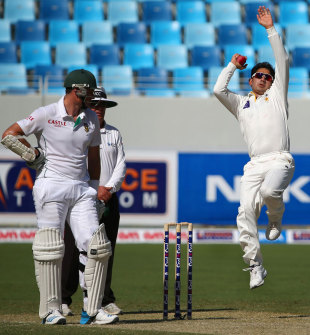An interview with Nagraj Gollapudi in Cricinfo
'Earlier the batsmen were scared to face me. Now there is a contest'
Saeed Ajmal talks about learning offspin afresh, how he plots dismissals with his remodelled action, and how ready he is for a Pakistan recall
"I watch my videos after every match to check if I have bowled any balls that are suspect. Ninety per cent of my deliveries are good"
Can we say in the last one and a half years you have had to learn offspin totally afresh?
I have relearned everything. Even with my body, I have had to start new exercises. Then I followed that up by bowling with a heavy ball. Everyone knows my right wrist is broken [in a bus accident]. The wrist bone protrudes out and my whole arm flexes. To get this under control, because it is already ten degrees, I have learnt to bowl with a heavy ball. To keep the wrist taut, my biomechanist, Dr Paul Hurrion, suggested I bowl with a heavy ball. I worked really hard. I bowled 12,000 deliveries during the rehab before coming back. I am developing those muscles. Initially I didn't have the pace, but thankfully my pace is up to 90kph.
From the time my action was called and till it was cleared, I have bowled at least 100 balls a day. When I had to clear my action I did a lot of bowling in that time. My body weight would fall on one side, my left leg would come up during the delivery stride. To avoid doing that, I strapped weights to my ankles so that the foot doesn't rise and come down flat upon landing.
Have you learnt new things about offspin that you didn't know before?
Definitely. I learnt a lot of things. I learnt that you can bring everything from your fingers if you are willing to work hard. At 38 I have learnt something that I probably never did in my 15 years as a cricketer. I had to become a child - like the first time I went into the academy as a ten-year-old. So I had to look at it like that again over the last year.
 Bowling with a remodelled action during a match against Kenya in December 2014, a few months after he was banned © AFP
Bowling with a remodelled action during a match against Kenya in December 2014, a few months after he was banned © AFPAfter you were banned, Saqlain Mushtaq was appointed by the PCB to work with you. Do you recollect the first delivery in the nets? Did you have to show Saqlain your action?
He knew what my action was before. Working along with Saqlain bhai, I changed my action eight times. Initially he would like the action for a while, say for a month, but then he would change it. After ten days he would be impressed with a different action, but then say it is not proving to be effective. He would keep liking it but was not totally convinced. It reached a stage where one day, I just said I would leave it [bowling]. But Saqlain bhai said, "Himmat na haar." [Don't lose hope.] One day it will come.
I kept doing it. Then I started bowling well and gained confidence. I am not saying I have become zabardast [great] once again. But with the matches I am getting to play, the crowds are coming, I am enjoying bowling under pressure, and one day I will be available to play for Pakistan.
How difficult is it to unlearn something you have known all your life?
I was bowling with my earlier action for 22 years. Even now, when I see videos of my old matches, different things come to mind. Batsmen's legs used to shake, every batsman used to think twice before stepping out to hit me, lest the ball bounces or turns. I can't forget those memories. Now when a batsman stares back at me I get angry. I think: till last year he used to cry, but why is he staring back now? To bring that back I have worked hard in the last six months to make my action effective and get back my pace. Now my pace is really good. Also my doosra, even though it is not as big as it used to be, is still there. There is topspin and it moves out a little bit. I am happy that I'm bringing that back.
Do you ever feel in a situation, physically, that your action might go back to the old one? You have played county cricket, bowled long spells. An old action is a habit.
No way. I will leave cricket with this [new] action. If I am not effective, I will step aside and leave. What I have done, I am happy with. I have been bowling about 90% with the new action. The odd ball might have exceeded 20 degrees, but I work hard immediately to rectify that. I watch every video of my matches. Ninety-nine per cent of my deliveries are under control. Since I have not played international cricket I will need to continue to work on how I bowl under pressure. I also need to work on how I bowl when I am relaxed.
I will be back, and that day is not far. I have spent a lot of time outside and it hurts me when Pakistan loses.
What I have learnt is that to learn anything new you have to believe in yourself and believe your Allah. There is nothing in this world that man can't learn. I learnt the doosra by myself. All I did was watch videos of Saqlain Mushtaq and in one month I had learnt it. I wanted to try it out in the next domestic season and I did.
To come back to international cricket, I need new variations, so I should be able to spin from the side, from down here, from the top, so I can deceive the batsman and let him know that I am now here.
Your weapons have changed. Now you don't do big spin, for instance?
In the last six months I have played 100-plus club matches [back in Pakistan] where I was also hit for many sixes. I was starting to understand at what pace the batsman was hitting me. I played club tournaments, local tournaments, a few outside. Slowly my confidence was coming back. In my mind I started thinking, "Now I am delivering my hand in the correct fashion." Earlier I had doubts, it was in my mind that I was chucking. It took me nearly a year after the ban to get rid of the fear and khauf [dread]. Now it is out and if you noticed my bowling in the last domestic T20 tournament in Pakistan and now in this, there is a big difference.
Has there been a difference in your mental approach towards a batsman with the new action?
My ability against the batsman has remained the same. I am mature enough to understand how to play the batsman. I understand where the ball will go if I press this finger and this finger [points to different fingers on his right hand]. I have taken a year just to master these fingers, only to get my confidence back so that one day when I return to the Pakistan team I don't want to feel that I am finished or that I have come on somebody's sifaarish[recommendation]. I don't want to feel like a liability. If I feel I am finished, I will retire.
Are the variations the same as you used to have?
There is a little bit of change. Earlier my deliveries used to have a lot of bounce. Now I have killed the bounce somewhat. Because of the high arm, my hand used to drop, so to stop the wrist from falling, I have now locked that wrist, so the spin is less. Earlier my right wrist used to fall away due to the bone injury. Now I have locked the wrist at the time of delivery. Consequently, the spin and bounce have reduced. But my variations remain the same. I have also learned to deliver with a low bounce against a tall batsman who stands and hits, or moves back to hit. In these matches, you will see a better version slowly.
 "Working with Saqlain bhai, I changed my action eight times" © ESPNcricinfo Ltd
"Working with Saqlain bhai, I changed my action eight times" © ESPNcricinfo LtdDo you still bowl the doosra?
Definitely. I have cleared the doosra during the ICC testing process. Even against Karachi Kings I got Saifullah Bangash with a doosra. I bowled a few to Iftikhar Ahmed. Out of 18 deliveries I bowled six doosras. Once again, with the doosra, there has been no difference in pace. The only difference has been with the spin and bounce when I deliver the doosra and the topspinner. I still rely on the doosra. I know it is a weapon that unnerves a batsman. With time my hand speed will get faster, as it was before. Then the doosra will become more effective.
Of the deliveries that were banned, which is the most difficult to change?
The offspin. My wrist used to drop, and as soon as it used to drop - for the doosra it is fine - for offspin I had to lock the wrist and when I let it go, it did not break. Because the wrist remains locked now. So I found it really difficult to spin the ball. People think it is very easy, but for me it is really hard because my wrist bone is broken. I always need to ensure that the wrist does not fall. Now the ball has started breaking, and as an example I got James Vince lbw [against Karachi] with the offspinner.
Did you ever think about your bowling as much as you have done in the last year?
The biomechanist Paul Hurrion has really helped me. To control the wrist it took a lot of time. I never thought about it. Earlier I would think, "This is Chris Gayle, or Pietersen, no problem." Now I have to think about where to pitch it, how to get the batsman out. Earlier the batsmen would be scared to face me. Now there is a muqabla [contest].
Muscle memory is an important constituent of any learning process. It can't be built in a year. How do you deal with that challenge?
I agree. But muscle memory is built when you start as a youngster. I am a mature spinner. It didn't take me that much time again because I know how to put the ball in. I already had the memory of where to bowl to what batsman and from where to deliver. My focus was just to clear my action. I cleared it very soon. I am very happy that I have developed the memory so quickly. I had almost lost hope. But I have this belief inside. I believe that everything I can put my head to, I can achieve.
You said you put some weights on your ankles. Can you talk about that? And also bowling with a heavy ball?
Saqlain bhai would strap my wrists with 1kg bands on both wrists. He did not want my front arm staying to the side and the bowling wrist high and locked. I also strapped 2.5 kg weights on my [left] leg to make sure it did not go high and the head did not fall down sideways. The head needed to be straight and relaxed. I would then deliver with a heavy ball. It took me three months just to get used to it, to develop muscle.
Do you reckon it is difficult for bowlers to innovate within the numerous stringent restrictions imposed by the ICC, as opposed to batsmen, who have the freedom to keep innovating and improvising?
Perhaps it is easier for the fast bowlers, considering they have two new balls in ODIs. It has become very difficult for spinners. Why did the spinners start chucking, bowling faster? Heavy, broad, big bats, a mishit would go for a six; Powerplays, four fielders outside the circle, five inside in the ODIs. Pitches have changed. What can spinners do in such a setting? Spinners had to learn something new, and so started bowling faster. Earlier if you flighted the ball, you would get respect. Abhi agar hawa mein do toh hawa mein jaata hai. [Now if you toss it up in the air, it disappears into the air.] With the playing conditions changing, spinners started to learn to bowl fast and the chucking issue became prominent.
Fingerspinners can't survive in international cricket, especially in ODIs and T20 cricket. The guy who does not have variety will be hit. You have to have variations, and for that you have to work hard, otherwise you are out.
 "I have this belief inside. I believe that everything I can put my head to, I can achieve" © Getty Images
"I have this belief inside. I believe that everything I can put my head to, I can achieve" © Getty ImagesCan you succeed as a spinner without throwing?
I have already given reasons as to why chucking started. There is nothing for the spinners. The ICC should allow spinners some relaxation. I said it to the ICC but it didn't make a difference.
Can you talk about examples where you enjoyed bowling after your action was cleared?
Last county season, I was playing for Worcestershire in a home one-day match against Leicestershire. Former England left-arm spinner Richard Illingworth, who played for Worcestershire, was the umpire. He asked me how I was going to get the batsman out. I told him I would bowl a whole over of offspin. He would push me to the leg side. Next over I would bowl the doosra and he would get caught at slip. So I bowled only offspin in the first over and the batsman played me to short midwicket. Next over, first ball, I bowled the doosra and he played it to the slips. Illingworth was astounded. I told him, this is cricket. I looked at what he was trying to do, and if he wins, it's fine. But what I was doing to him, that is in my control. I was making him play on my terms, not his.
So one thing that has not changed is how you out-think the batsman?
That cannot change. Against Karachi, bowling to Iftikhar Ahmed, I knew he plays to midwicket. So I was playing with him. First up, I bowled him a doosra. It was a little outside off stump. I know he does not step out, and he was beaten. I bowled him another doosra which pitched on the same spot. He went for a big hit and was beaten. I then bowled offspin from the very same spot. He was beaten again and he stared back at me.
I look for cues in a batsman. Kamran Akmal straightens his left leg to hit over midwicket. Sarfraz [Ahmed], if his shoulders are bending low, he is going to play the sweep. If he is standing normal and straight, he will not sweep. I have to pick this. Kevin Pietersen can hit a six by stepping out or by standing inside the crease. So I know to bowl it wide, so even if he hits, it might go high up in the air. I have learnt all this by playing for long, by playing with the batsman's mind, by learning to watch what the batsman is doing. You need to do your homework. You need to read the pitch, to understand how much bounce there is on the pitch. So you will need to figure out whether to flight it or not and such stuff.
How far away are you from playing international cricket?
I look for cues in a batsman. Kamran Akmal straightens his left leg to hit over midwicket. Sarfraz [Ahmed], if his shoulders are bending low, he is going to play the sweep. If he is standing normal and straight, he will not sweep. I have to pick this. Kevin Pietersen can hit a six by stepping out or by standing inside the crease. So I know to bowl it wide, so even if he hits, it might go high up in the air. I have learnt all this by playing for long, by playing with the batsman's mind, by learning to watch what the batsman is doing. You need to do your homework. You need to read the pitch, to understand how much bounce there is on the pitch. So you will need to figure out whether to flight it or not and such stuff.
How far away are you from playing international cricket?
I am ready. There is a big difference from the time when I played in the Bangladesh series last year after I was cleared. At that point I had the fear on the inside. Now I have removed that fear by working hard.
